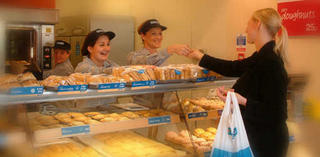Jamster
Jamster the ringtone, logos and java games company most famous for its crazy frog ringtone TV adverts has been all over the media this week with the success in the UK charts of a single based on the ringtone.According to the Financial Times on Saturday the company has sold about 11 million Crazy Frog ringtones across Europe at about 3GBP a time. Lets be generous and allow them a cost of transcation of about 0.15GBP, giving a potential pre-tax profit of about 31.5 million GBP. This doesn’t take into account the cost of making the ads, online advertising, business infrastructure etc.
Now in the UK according to anonymous sources quoted by media gossip newsletter Holy Moly, they have spent about 30 million GBP on TV advertising. Given the amount of times that I see the adverts when I go to the gym, I suspect that this number is not far off the mark. So, the frog is not as profitable as it would first seem. In addition, the adverts do not drive traffic to the Jamster website where they can cross promote other products, but flash up a short code number that you SMS for your ringtone.
Where it gets really interesting according to the same sources is that from the a TV advertising point of view is that the ringtone adverts are apparently driving down the cost of TV ads. Understandably advertisers generally don’t want to appear in the slot after a Crazy Frog ad as a large proportion of the audience will have channel surfed off until the programme is back on, this means that the TV channels finding it harder to sell on these slots. The big mystery is why they haven’t told Jamster to get lost yet? More wireless related posts here.
Class and consumption
The New York Times has run a very interesting article on class and consumption in the US. When the Jones’ wear jeans talks about how technology, low inflation and consumer credit has levelled the playing field for the consumption of luxury goods and that the rich are more likely to be diffferentiated by the personal services they consume like plastic surgery, a nanny and a personal chef.
Key take outs:
- With the demise of the community and the rise of mass media, people are less likely to be bothered about keeping up the Jones’ (ie their local community) and more bothered about getting their fair share of what the rich have
- Consumption is patchy, people may shop for discount brands but still like Starbucks coffee, iPods and designer jeans
- About half of Americans now have a cell phone (there is about 176 million cellphones in the US), the cost of a cellphone has fallen to about an eighth of what it was a decade ago
- Department store prices have fallen by about 10 per cent in the last decade
- The new hot segment in the car market is ‘sub-luxury’ cars (like the BMW 1 series and the Audi A3)
- American consumer debt is about 750 billion USD, up about six-fold over the past 20 years
- I found it interesting that the article made a big play about how marketers are having to move from income and gender (socio demographic) segmentation to lifestyle and interests. (Are US marketers way behind the UK in this respect? I would have thought that the likes of P&G would have led the way rather than followed?)
Finally a quote from a spokesperson from Godiva – the chocolate firm: “People want to participate in our brand because we are an affordable luxury,” said Gene Dunkin, president of Godiva North America, a unit of the Campbell Soup Company. “For under $1 to $350, with an incredible luxury package, we give the perception of a very expensive product.”
renaissance chambara says that it goes to show the old maxim that perception is reality.
 The New York Times has an interesting article about how Sean Coombes is trying quite successfully to walk his urban fashion label out of the cliche it had become. Though his business is worth some 400 million USD annually, Coombs has seen the writing on the wall of the scene and rather than cater for the limited market of Ali G impressionists is trying to move more upmarket. The urban fashion scene has become as tired as the sound of R&B and rap music, in the way that 80’s rock got into treading the same groove over and over again to make money.
The New York Times has an interesting article about how Sean Coombes is trying quite successfully to walk his urban fashion label out of the cliche it had become. Though his business is worth some 400 million USD annually, Coombs has seen the writing on the wall of the scene and rather than cater for the limited market of Ali G impressionists is trying to move more upmarket. The urban fashion scene has become as tired as the sound of R&B and rap music, in the way that 80’s rock got into treading the same groove over and over again to make money. 

